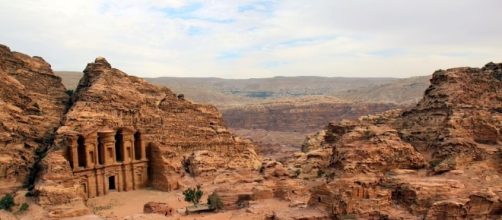The Treasury
Petra needs no introduction. Located in present day Jordan, it is mention in the Bible and was explored by T.E. Lawrence (Lawrence of Arabia) during his First World War exploits. The famous facade of the Treasury is perhaps the image most associated with this ancient Nabatean city.
Navigating the narrow passageways, rocks flanking you on both sides, and having the seamless, hand-carved Treasury building slowly revealed is a memorable experience. Particularly at dawn, when the sun gives a unique rose colour tint to the imposing exterior of the Treasury and the six smooth columns supporting it - this is where the remarkable achievement of the Nabateans is highlighted most.
However, it could be said that the Treasury is a victim of its own success. Although nothing compares to seeing it in person, thanks to Hollywood movies and multitudes of travel photos people know what to expect. The intrigue and mystery of the Treasury has, unfortunately, been lost.
There are interesting undiscovered Treasury tidbits though; such as the urn which is perched on top of the structure peppered with Arab bullet holes - believing that it contained treasure they shot at it but did not receive any riches. Despite this engaging side story most of us are largely accustomed to what the Treasury has to offer.
The Monastery
Thankfully, the city of Petra is far more than just the classic Treasury building.
Walking for forty-five minutes up centuries old, hand-carved stairs with sheer drops on one side and impatient tourist-ferrying donkeys on the other you will eventually reach the Monastery.
Much like her more famous sister down below, entrance to the Monastery involves a fairly narrow entrance guarded by walls of rock on both sides, opening up to a surprisingly spacious sand covered patch of land with the occasional bit of shrubbery. Turn right, however, and the much more rugged and weathered face of the Monastery stares back at you.
Believed to have been utilised not only by the Nabateans who built it but by the Greeks, Romans and Byzantines - the wind eroded Monastery has a past just as captivating as the Treasury.
This unexpected, centuries old attraction stands opposite the relatively modern cafe "at the top of the world," as the locals call it. Sitting on the comfy benches with a Turkish coffee and an unhealthy snack (as a reward for climbing all those stairs) you are able to truly sit in awe of the Nabatean people and their creation.
Petra is a city more than the Indiana Jones flashback inducing Treasury. Indeed, the lesser known Monastery and unanticipated astonishment that it offers gives you a fresh feeling of admiration, wonderment as well as a humble concession that the Nabateans were geniuses.


